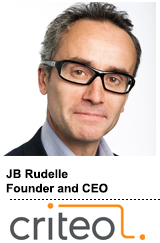 With the rapid pace of change in the advertising technology industry, a couple of years can seem like a generation of change.
With the rapid pace of change in the advertising technology industry, a couple of years can seem like a generation of change.
Which is why it was a surprise to see JB Rudelle, Criteo’s founder and CEO until 2016, return as chief executive in April, retaking the reins a month before the implementation of GDPR.
Rudelle had been chairman of the board prior to resuming his role as CEO, so he hadn’t lost touch with Criteo’s business.
“Still, the mindset of players in the market has changed a lot in the past few years,” Rudelle said. Media budgets and ecommerce dollars, for instance, have consolidated to the largest players in the space.
AdExchanger spoke with Rudelle about how Criteo plans to adapt to and grow in this new marketing and ecommerce landscape.
AdExchanger: What are you thinking about in terms of Criteo’s road map and potential growth opportunities?
JB RUDELLE: I’ve spoken to a lot of clients in the last four months. It’s interesting to see the mindset today. For a long time, we’ve been a technical solution that worked well and was very efficient. That’s how Criteo has been growing for years. Now we’re at a point where clients are looking for strategic partners and want to engage with us in broader discussions.
How so?
For one thing, clients want to have a more full-funnel approach. They understand how their marketing funnel works from acquisition down to conversion and then into loyalty and upselling. We previously didn’t have clients that could identify or adapt messaging based on whether someone is a new visitor, client, prospect, buyer or repeat buyer. Now they have sophisticated lifetime value calculations.
The second thing is apps. Used to be most clients couldn’t justify building an app. Now there’s a big change in mindset and we see much more appetite for app installs, app engagement and in-app conversion. That’s an area we’re putting a massive investment into.
And the other main growth opportunity is that Amazon’s ad business has made the retail industry realize there’s serious money to be made in data monetization. They don’t have Amazon’s R&D and product but want to capitalize on data as they haven’t before.
Criteo has built up a sizable cash position. Are you considering acquisitions and if so what kind of companies are you looking for?
We want to fill whatever gaps we have in our portfolio of products. By default, we fill those gaps by organic R&D, but it doesn’t make sense to remake the wheel for everything.
Take our recent acquisition of Storetail. The days of IAB formats are over. If you want to be effective, you have to be native. And that’s true of ecommerce too. That’s an example of something we could have decided to build, but thought it was faster to acquire and scale the right company.
Criteo has announced a series of integrations and partnerships with companies across the mar tech landscape. Is that part of you being a more strategic partner?
I’d say that goes hand in hand with the philosophy where we want to be seen much more as a platform rather than purely packaged products. Platforms need to be able to communicate and interact with the whole ecosystem. We’re agnostic on whatever DMP our clients are working with, for instance. And we have a similar philosophy for mid-market. It’s why we’ve integrated in Shopify and other ecommerce platforms.
What are the demands in terms of product development and resources for those kinds of partnerships?
We have the opportunity with the scale we have to afford such an approach. We have more than 700 people in R&A and product, so we can support this investment. If we were smaller it would be much harder to do.
How has the market changed due to GDPR?
The vast majority of the market is converging on a solution that I believe is a reasonable balance of user control of data and user experience. The risk is it’s easy to end up pushing consent notifications and opt-ins over and over and end up undermining the browsing experience.
And some people don’t have a consent management plan in place. But that’s where the market is going and something our clients really need to offer to users.
What are your thoughts on the IAB Europe Transparency and Consent Framework, where you’re integrated as a global vendor but not as a consent management platform?
There’s the advertising industry way of looking at things, but for the end users those discussions can be super hard to understand. Not every person is going to know or care about 10 or 20 companies a merchant might work with. They want to know how the data is being used and for what marketing applications.
What we’re promoting is what I would call the open internet consent: the ability for every advertiser to choose whatever technology they want, make sure it works across the ecosystem and keep control of their data.
This post was syndicated from Ad Exchanger.


More Stories
Macca’s spiciest burger ignites taste buds!
Why Caitlin Clark Will Be Worth It for Nike
Fintech’s On-Ramp To Retail Media; Does YouTube Count As CTV, Digital Or Both?